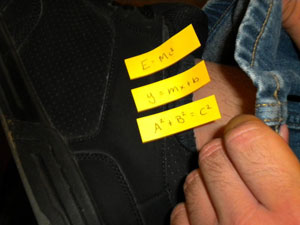
Student demonstrates an example of how he prepares his "foot notes" before a test. Photo by Anaiah V. Liserio
It happens to every student, in every classroom, in every school. Someone close to you is stealing your work.
"I would say something to the student I saw cheating and let them know that what they’re doing is unfair," said Lizzet Martinez, an Education major; however, Martinez said that the situation would depend on the person.
"If I think that this person is going to cause me problems, then I might just let it go, but that’s why I think there should be a place where we can let someone know without them finding out," she said.
Copying answers from another person’s homework or test and using it as your own is cheating. Claiming another person’s work without citing or acknowledging it is plagiarizing. Collaborating with another person and preparing unauthorized course work is collusion. All of these are examples of scholastic dishonesty.
The Alamo Colleges have a zero tolerance policy for this type of academic misconduct.
To keep students informed of these rules, each professor hands out his/her department-approved syllabus at the beginning of the semester. A section in the syllabus describes the rules pertaining to scholastic dishonesty. This is a written warning to students that action will be taken if they are caught cheating, plagiarizing or colluding. What most syllabuses fail to mention is what students should do in the event that he/she witnesses someone being dishonest.
In the Student Handbook for Palo Alto College, the rules are spelled out for faculty members who originate the allegation. What course of action a student should take isn’t covered. Many students who would prefer to stay anonymous feel uncomfortable with the idea of addressing the situation and would rather report the misconduct online or by telephone. However, some would prefer not to say anything at all.
Education Major Christina Bocanegra said she chose to remain uninvolved when she witnessed someone cheating.
"I believe in karma," she said. "If it’s not in my own personal life journey, then it doesn’t bother me."
Many students interviewed on campus were unaware of the chain of command to pursue if they did want to report scholastic dishonesty.
First, raise the issue with your professor. If the matter still continues, then see the chair of the department. From there, visit the dean, vice president of Student Affairs and lastly, our president.
To identify scholastic dishonesty, Palo Alto subscribes to a program called Turnitin. This program prevents plagiarism, checks originality and helps educators identify students who misunderstand academic integrity. The faculty of the Alamo Colleges’ English Departments use the program, as do professors of writing-intensive courses.
Assistant Professor of English Ruth Ann Gambino said that the program helps students check their work against a huge database of previous student papers.
"They can see what percentage of each paper they submit is original, and whether they are quoting too much," said Gambino.
English Instructor Caroline Mains primarily uses turnitin.com as a plagiarism- prevention tool.
"I give my students access to the site so they can submit their work and check their documentation of sources before they turn in assignments to me," said Mains.
Vice President of Student Affairs Dr. R. Michael Flores explained that in the time he’s been vice president, hardly any allegations have come his way. "Most incidents are addressed by the faculty member and then by the department chair," said Flores. "Very few incidents end up going to the individual deans or the vice president. I think it speaks highly about our students on how they conduct themselves, and then also to the faculty."
To learn more about Students Rights and Responsibilities, consult our Student Handbook listed under Student Services on the website.